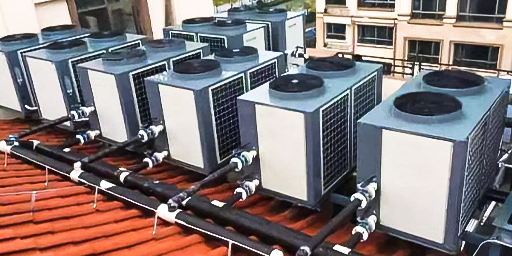Air energy heat pump knowledge training
1. Name the Explanation
Air source: heat energy comes from the air; in addition, there are water sources, ground sources, etc.
Air energy: air is not a kind of energy, the form of energy includes electric energy, heat energy, solar energy, and so on.
Heat pump: A device that uses high-level energy to flow heat from a low-level heat source to a high-level heat source.
2. Principle of air source heat pump water heater
Heat pump technology is based on the reverse Carnot cycle principle. It is mainly composed of four parts: compressor, condenser, expansion valve, and evaporator.
3. Product Structure Introduction of Air Source Water Heater
Air source heat pump: A device that uses air as a low-level heat source and absorbs heat from it to a high-level heat source. the
Water source heat pump: A device that uses water as a low-level heat source and absorbs heat from it to a high-level heat source. the
Ground source heat pump: The underground pipe is used as a low-level heat source, and heat is absorbed from it to a high-level heat source.
Swimming pool unit: a heat pump unit dedicated to constant temperature heating of the swimming pool.
Air-conditioning heat pump: capable of cooling, heating, and producing domestic hot water devices (triple supply).
Hot and cold water unit: A device that can produce cold and hot water separately or simultaneously.
Air source-water source heat pump: A device that can absorb heat from air and water alone or simultaneously from air and water to a high-level heat source. the
Classified by heating temperature:
The high-temperature heat pump (above 65°C);
The low-temperature heat pump (below 60°C).
Classified by the heating method:
Direct heating: heat the cold water to the set temperature at one time.
Circulation type: multiple cycles to heat the cold water to the set temperature.
Immersion type: put the heat exchange tube directly in the heat preservation water tank, and heat the cold water to the set temperature.
According to the working temperature:
Ordinary type General working temperature range: -5°C -43°C.
The broad working temperature range of low-temperature type: -15℃-40℃ is suitable for the area north of the Yangtze River.
According to the working voltage:
Single phase 220V.
Three-phase 380V.
According to the type of air outlet of the machine:
Top out the wind.
Side (horizontal) out.
According to the refrigerant heating method:
inner coil.
Outer coil.
4. Functions of air source heat pump components
1) Compressor: Its function is to suck in the low-temperature and low-pressure refrigerant vapor from the evaporator, compress it into high-temperature and high-pressure superheated refrigerant vapor and then discharge it to the condenser.
2) Heat exchanger: The evaporator of the air source heat pump water heater basically adopts flat sheet hydrophilic aluminum foil. The low-temperature and low-pressure liquid refrigerant absorb heat and converts to low-temperature and low-pressure steam.
Water condenser: The water is in a turbulent state in the copper tube, which is not easy to scale, has strong antifreeze ability, is not easy to be blocked, has low requirements on water quality, and is cost-effective.
Plate heat exchanger: Water and refrigerant flow at intervals in the sheet, with sufficient contact and high heat exchange efficiency. It is suitable for units with large power. The price is more expensive, the antifreeze ability is poor, the water quality requirement is high, and it is easy to block.
Shell and tube heat exchanger: high heat exchange efficiency, small size, not easy to block, can be used in any unit.
Submerged coil condenser: simple structure, not easy to clean after scaling, long time, poor heat transfer efficiency, poor corrosion resistance of copper tubes, which may cause coil leakage.
Swimming pool titanium tube heat exchanger: composed of titanium tube and PVC plastic shell or stainless steel shell, the maximum temperature is limited below 45°C.
3) Throttling part: Throttling and depressurizing the high-temperature and high-pressure refrigerant liquid coming out of the condenser into a low-temperature and low-pressure liquid, and then discharging it into the evaporator.



